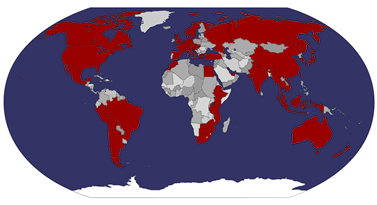The taxi had not replied to my message, so I chapa it back to the airport, 12M for two chapas, quite a saving on 250M for a taxi, though of course it is extremely hot and uncomfortable with my pack sitting on my lap (for an extra 5M I could have bought another seat of course, but I like to go for one extreme to the other). At the airport, I have to wait till check in time, when I’m issued with a hand-written boarding pass, which gets a sticker put on it when I pay the 200M departure tax.
Boarding is chaotic, with people walking out through a separate gate to same plane we later board, passengers opening security doors and wandering out on to the tarmac themselves. A plane taxies past us as we walk across the tarmac. On board, we’re flying to Nampula then Pemba. I have a slight wish I were going to Pemba, to avoid the inevitable bus fun in Nampula. But, it’s good to be flying again!
We climb up over a quite interesting terrain, with a mix of swamps, rivers curving about, forests, sand dunes. They serve a snack as we cross the Zambezi river, I’m hungry. Descending into Nampula, the landscape is dotted with interesting rock formations dotted about, like Halong Bay on land.

As I walk to the main road to take a chapa, worried that it’s too late to get to Ilha de Mozambique (henceforth referred to as Ilha), a truck stops, and the Muslim woman, called Sarah, driving asks me where I’m going. I reply, and she offers to take me to the bus. I jump in the back with her kids. Before the station, we pull up at her family’s house. Some discussion reveals that her brother is going to Ilha this afternoon and will give me a lift there. This is true Islamic hospitality on show again. They say that he has to do a job first, and so he’s not sure when he’s going, if at all this afternoon, so I opt for the bus. She runs me up to the terminal, finds the bus for me, and makes sure my bags are secured, admonishing the person putting my main pack on the roof that it better be safe. So very kind of her.
The bus is packed already, so I’m standing for the four hours or so it will take. Any hopes that people will get off at intermediate stations are unfounded – this is an express bus, everyone’s going all, or at least most of the way. I read Tilman. The chap standing next to me (as in a couple of inches from my face) is impressed, sees the black and white photos, and tells me Mozambicanos aren’t so interested in history in general. He buys some cashew nuts from the sellers that hound the bus at every stop, drops several on the floors, picks them up and eats them, offering me some, I decline.
When we arrive, we are transferred on to a smaller chapa shuttle for the run across the causeway. I had the impression from the book that Ilha was connected to the mainland by a small spit of land, but it is in fact a man-made causeway, a single lane road with passing points. Most people are walking or cycling back and forth. Arriving, I’m taken under the wings of three young girls, Batul, Zeituna and Suraya, who offer to show me about. They take me past the Green Mosque to the Museum, near which is supposed to be a tourist information office. It turns out to be closed, as torrential rain starts, so I suggest we duck into a bar (Reliquias) for a drink, and to avoid the rain. Our drink finished, they’re raring to go. In the pouring rain? I’m not very keen, and on my own would have just sat it out, but as it is, we march out into sheet rain, and of course get drenched.

Only when I unpack my things at Casa de Luis do I realise the implications of this. My Tilman volume, which I’m so fond of, has received a severe soaking. I’m very disappointed about this. My notarised copy of my passport is on its last legs too, though this is not so much of an issue. I hope the rain stops soon so I can dry things. I can’t see myself staying here more than a couple of days, though the girls have offered to take me along when they visit their Grandparents tomorrow morning, taking a 6am boat to another island.
A little later, my unexpected roommate appears – Scott, a PeaceCorp volunteer from Nebraska. So now I understand her reference to the price of the room being 250 for one and 500 for two. She meant if she finds me someone to stay with, not if I do! Anyway, he seems nice, we chat a bit then head out for some food in the now light rain. The place our landlady recommends, Zavala, doesn’t appear to have any food left – they offer us some beans and rice, so we press on, and end up at Reliquias again. It’s full because of some function, so we are taken out to the back, where a couple of Japanese girls are sitting, so we join them. They apparently both work for non-profit organisations too. Bunch of hippies!
I have the prawn curry with rice, and of course plenty of beer. Scott has the grilled prawns, which are quite expensive, though the girl in Casa de Luis later explains that it’s because they don’t come from round here. I’d been told something similar for Vilhanculo.
Exploring the Ilha
The early-morning trip out to the other island falls through, thankfully. Instead Scott and I head out to explore the island. It’s not that large – I think you could probably do the full circuit in a couple of hours. Apparently though there are over 12,000 people living here, which is hard to believe not only in terms of the size of the island but also it just doesn’t feel that busy.

Scott in front of Casa de Luis
First stop, a church on the south end of the island, San Antonio, set on a rocky outcrop by itself.


This is at the end of a beach which has to be seen to be believed.

It is basically the toilet of makuti town, the reed town.

Plop plop
All along it one can see adults and children squatting down pooping, most on the sand, some in the water. Children splash about and play a few metres away.

It’s enough to put you off your breakfast.

Yes that is what it looks like stapled to the tree

Passing along the main street, we pass the hospital. I didn’t believe the place was still in use, as it looks like some sort of grand old ruin, but apparently it is still the main hospital.

The beautiful gate

Hospital buildings


Strange graffiti
On one of the streets I notice the following sign, which to me sounds like an excuse for some fun diving paid for by someone else – Subaquatic Archeology! :


As you can see from the photos, it was clearly a very beautiful place once upon a time. Now though, it has completely fallen into disrepair, except for one block which seems to be expat-owned.


How it all could and should be…

But unfortunately how much of it is.
We brunch at Café Ancora, which is nice but for the plagues of flies and heat.

Scott’s friend, whom coincidentally the previous day I had talked to joins us. She’s just come here and will be spending two years on the island teaching English. Two years! I’ve been here less than a day and I’m running out of things to do!

We walk together round past the Sacred Art Museum and Church of the Misericordia.


And the newly-constructed school to the beach and the Fort.


Incidentally Stonetown was constructed by rock quarried on the island. Then the Makuti Town, of reed houses, was constructed in the quarry pits, explaining why they are set down below ground level, and have no sewage system.

Reed houses set down below ground

The Fort Gate

Imposing walls
We are charged 50M entry fee, which we are initially highly suspicious of, but relent when we are issued with an apparently genuine ticket, despite it being printed out on regular paper and photocopied. I have no doubt that none of the money goes on preserving the fort however.

Fort Gate from inside

Plenty of space inside
The Fort of Sao Sebastiao dominates this end of the island, and is supposedly the oldest building in Southern Hemisphere. It was built to defend what was the capital of Portuguese East Africa, though has subsequently been used for a variety of purposes, including more recently as a school.

I find that the ground is littered with small prickly things which now my shoes are worn poke right through with their thorns. It’s not comfortable walking for me!

We head up on to the ramparts.




At the far end outside the walls is a small chapel which is quite beautiful and interesting.


Above the door

Inside




As we leave, we note with both sadness and amusement that the scale model of the side near the entrance is also in ruins, not deliberately, just through lack of care, exactly mirroring the real site! What faithful attention to detail!!

The scale model, also in ruins!
Next to the fort is the main beach, thankfully the other side of the island from the poop beach, though still not far enough for complete peace of mind.

I paddle and find the water so warm, it’s not even refreshing. Water temperature here is about 30C!

I leave Scott here, and apparently shortly after I go, dolphins swim past the beach, but not for me. Instead I visit the museum, housed in the Palace of Sao Paulo.


It’s a beautiful building, but the interior is concerned mainly with period furniture and preserved bedrooms, not really my forte. More annoyingly I have a chap who doesn’t speak English shadowing me for my whole visit, and directing me where he thought I should walk.

The chapel

I get another person who takes me round to the very small Museum of Sacred Art.

It turns out to be a single room with some of the objects preserved from the various churches on the island.
Back home, I finally get my hands on some drinking water, I was so desperately thirsty after Scott’s friend had told me not to buy water in Ancora as it was too expensive, with the consequence that I suffered in the heat for a few hours for the sake of a few pence! I change into swim gear, meet the girls and head back to the beach for a swim. It’s very pleasant, though in my mind is the time of the bus that I am skipping out of town on tonight, about 3:30am specifically! What is wrong with Mozambicans and their choice of bus time? It just doesn’t make sense. Anyway, post swim, we waddle back at African female walking pace, and I pop home and shower before the girls come round for dinner.


We walk together to O Escondidinho, which is supposed to be the best hotel on the island, also with a nice restaurant. I don’t really like the feel of the place though, so we end up back at the old favourite, Reliquias. The night ends with a beer or two with Scott at Zavala before we head home for a couple of hours sleep.




No comments:
Post a Comment